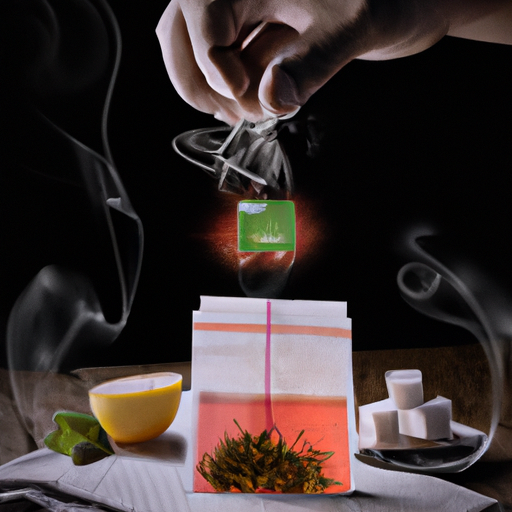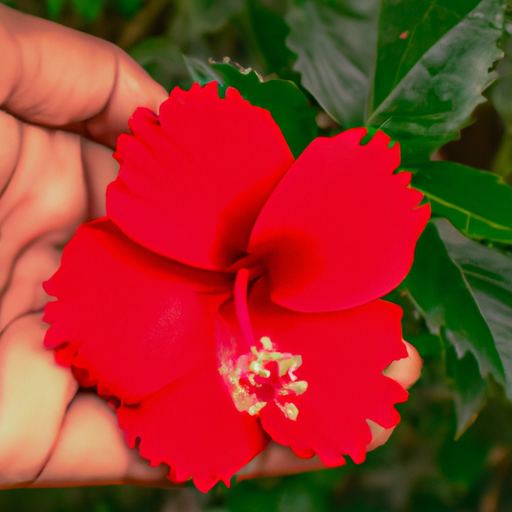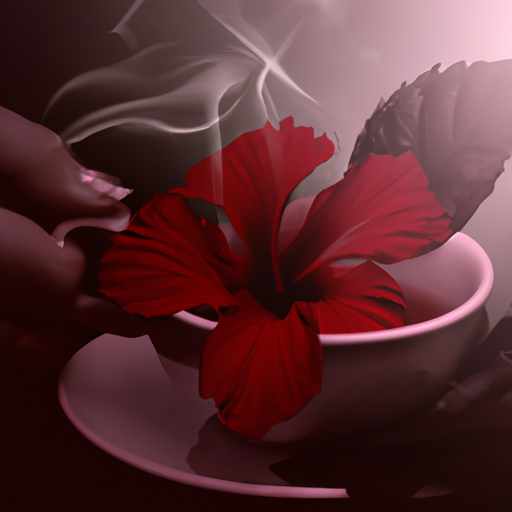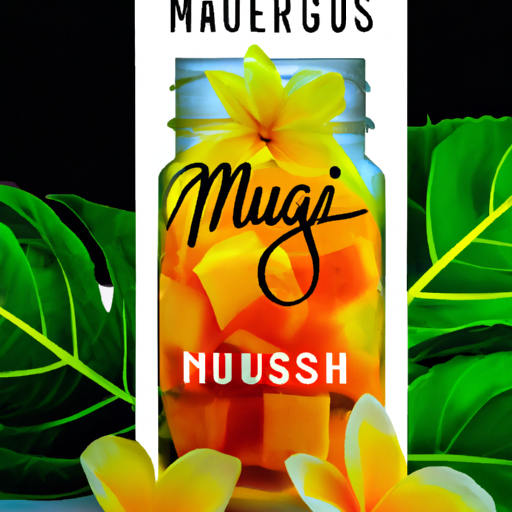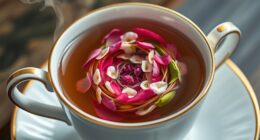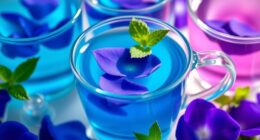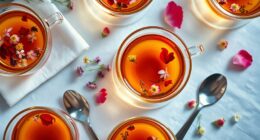Hello! Are you in search of a tasty and nutritious option to keep yourself hydrated? Search no more, for hibiscus tea is here!
This flavorful beverage is not only refreshing but also packed with health benefits. Hibiscus tea is made from the dried flowers of the hibiscus plant, which are high in antioxidants and can help lower blood pressure and cholesterol levels. It’s also a great source of vitamin C and has anti-inflammatory properties. Plus, it’s caffeine-free, making it a perfect option for those looking to cut back on their caffeine intake.
In this article, I will guide you through how to make hibiscus tea so that you can enjoy all its benefits in the comfort of your own home.
Key Takeaways
- Hibiscus tea is made from dried flowers of hibiscus plant and is caffeine-free.
- It is high in antioxidants, can help lower blood pressure and cholesterol levels, and is a great source of vitamin C.
- Hibiscus tea has a tart, cranberry-like flavor and pairs well with sweet fruits like strawberries and peaches, as well as tangy citrus fruits like lime and lemon.
- To make hibiscus tea, steep leaves in boiling water for 5-7 minutes, add honey or lemon to enhance flavor, and store brewed tea in an airtight container in the refrigerator for up to 3 days.
Health Benefits of Hibiscus Tea
You’ll be amazed at how much better you’ll feel after drinking hibiscus tea, with its ability to lower blood pressure and improve heart health. Traditional uses of hibiscus tea include treating high blood pressure, liver disorders, and even colds.
Scientific studies have shown that hibiscus tea contains antioxidants that help prevent damage from free radicals in the body. Hibiscus tea has been found to have a significant effect on lowering blood pressure in people with hypertension. In fact, one study showed that drinking three cups of hibiscus tea daily for six weeks resulted in a reduction of systolic blood pressure by an average of 7.2 points. This is comparable to the effects of some medications used to treat hypertension.
In addition to its cardiovascular benefits, hibiscus tea may also help reduce inflammation in the body and improve digestion. With all these amazing health benefits, it’s no wonder why so many people are turning to this tasty herbal drink as their go-to beverage choice!
Now let’s move on to how you can prepare your own delicious cup of hibiscus tea at home.
Preparation of Hibiscus Tea
First things first, steeping the dried hibiscus flowers in hot water for a few minutes is the key to unlocking their full flavor potential. To prepare hibiscus tea, simply boil some water and pour it over a handful of dried hibiscus flowers. Let it sit for about 5-7 minutes or until the infusion time has passed, depending on how strong you like your tea. You can adjust the amount of hibiscus flowers to water ratio depending on your preference.
Hibiscus tea has a unique flavor profile that is tart and slightly sweet at the same time. It has been described as having notes similar to cranberries, cherries, or pomegranates with some earthy undertones. The longer you steep the tea bags or loose leaves, the more concentrated and intense the flavors will be. However, if you leave it too long, it may become bitter.
Preparing hibiscus tea is simple yet rewarding. With just a few steps and minimal ingredients required, anyone can enjoy this delicious beverage packed with health benefits. In the next section about variations of hibiscus tea, we’ll explore different ways to customize your drink by adding herbs or spices to make it even more delicious!
Variations of Hibiscus Tea
There are countless ways to switch up your hibiscus infusion, from adding fresh fruit slices to infusing it with herbs and spices. Here are some variations of hibiscus tea that you can try:
-
Flavors: Hibiscus tea has a tart, cranberry-like flavor that pairs well with sweet fruits like strawberries and peaches, or tangy citrus fruits like lime and lemon. You can also add honey or agave syrup for sweetness.
-
Recipe modifications: If you want a stronger hibiscus flavor, use more dried flowers when making the tea. Alternatively, you can mix in other teas like green or black tea for added complexity.
-
Herbal infusions: Adding herbs like mint or basil to your hibiscus tea can give it an extra boost of freshness and aroma.
-
Spices: Experiment with spices like cinnamon, ginger, or cardamom to create a warming winter drink or a refreshing summer cooler.
With these recipe modifications and flavor options, there’s no limit to the versatility of hibiscus tea! Now let’s move on to how to serve this delicious beverage at home without any fussing about complicated steps involved in the process.
Serving Hibiscus Tea
Imagine sipping on a refreshing and flavorful beverage that’s perfect for any occasion – serving hibiscus tea is simple and enjoyable.
When it comes to presenting this vibrant drink, there are a few tips that can make all the difference. Firstly, consider adding ice cubes or chilled water to enhance its thirst-quenching qualities. You could also add some fresh fruit slices, such as orange or lemon, to create a colorful and appetizing display.
In terms of flavor pairings, hibiscus tea pairs well with both sweet and savory dishes. For a sweet treat, try serving it alongside some freshly baked pastries or cakes. Alternatively, for something more savory, pair it with spicy snacks like roasted nuts or chips with salsa. The tartness of the hibiscus complements these flavors perfectly.
Now that you know how to serve your delicious hibiscus tea in style and pair it with complementary foods, it’s important to think about storing any leftovers correctly. To ensure maximum freshness and flavor retention, store your brewed tea in an airtight container in the refrigerator for up to 3 days. This way you can enjoy your tasty beverage anytime without worrying about losing any of its goodness!
Storing Hibiscus Tea
Just like how a flower needs proper care to maintain its beauty, hibiscus tea should be stored in an airtight container in the refrigerator to retain its freshness and flavor. Storing hibiscus tea properly is important because it can affect the shelf life of the tea. If not stored correctly, hibiscus tea can lose its flavor and aroma quickly.
Airtight containers are ideal for storing hibiscus tea as they prevent moisture from getting inside and causing spoilage. You can store loose-leaf or bagged hibiscus tea in an airtight container. Make sure to label the container with the date you purchased or brewed the tea so that you know when it’s time to use it.
It’s important to note that hibiscus tea has a relatively short shelf life compared to other teas. The best way to ensure your hibiscus tea stays fresh is by consuming it within six months of purchase or brewing.
With proper storage techniques, you can enjoy fresh and flavorful cups of hibiscus tea every time! Now, let’s move on to some brewing tips for making delicious cups of this refreshing drink.
Brewing Tips
To brew a delicious cup of hibiscus tea, you’ll need to steep the leaves in boiling water for 5-7 minutes and add honey or lemon to enhance the flavor.
There are several brewing methods you can try to achieve the perfect cup of tea. One method is to use loose leaf hibiscus tea and a strainer ball or infuser. Another method is to use pre-packaged tea bags, which are convenient for on-the-go brewing. Lastly, you can make a large batch of hibiscus concentrate by simmering the leaves with water and sugar, then diluting it with hot water when ready to drink.
The quality of your hibiscus tea will depend on the brewing method you choose. For loose leaf tea, be sure not to oversteep the leaves as this can result in a bitter taste. Pre-packaged tea bags may have added flavors or ingredients that affect the overall taste and quality of your brew. If making a concentrate, be mindful of how much sugar you add as this can greatly impact the sweetness level of your final product.
Incorporating these tips into your brewing process will help ensure a tasty and satisfying cup of hibiscus tea every time. Now let’s explore some references and further reading materials for more information on hibiscus teas and their health benefits.
References and Further Reading
Now that we’ve gone over some helpful brewing tips, let’s look at where you can find more information on making hibiscus tea. As someone who enjoys exploring cooking techniques and herbal remedies, I always like to do my research when trying out a new recipe or beverage.
One great resource for learning more about hibiscus tea is the internet. From blogs to articles, there are countless websites that offer step-by-step instructions and creative variations on this refreshing drink. Some of my favorite sites include wellness blogs like MindBodyGreen and Healthline, as well as food-focused pages like Bon Appétit and Epicurious.
In addition to online sources, there are also several books dedicated solely to the topic of herbal teas. Whether you’re a beginner or an experienced tea drinker, these resources can provide valuable insights into everything from sourcing ingredients to understanding flavor profiles. Some popular titles include ‘The Art of Tea’ by Rebecca Sullivan and ‘Tea: History, Terroirs, Varieties’ by Kevin Gascoyne et al.
With so many options available, it’s easy to become inspired and start experimenting with different ways to make your own delicious cup of hibiscus tea!
Frequently Asked Questions
What are some potential side effects of consuming hibiscus tea?
As someone who’s consumed hibiscus tea before, I can say there are indeed potential side effects to be aware of.
Some people may experience stomach discomfort or nausea after drinking too much hibiscus tea, so it’s important to be mindful of your dosage.
Additionally, hibiscus tea has been found to lower blood pressure. This could be beneficial for some individuals but potentially harmful for others if the dosage is too high.
It’s always a good idea to consult with a healthcare professional before incorporating any new herbal remedies into your routine. Also, make sure to follow recommended dosages carefully.
Can hibiscus tea be made using dried or fresh hibiscus flowers?
When it comes to making hibiscus tea, both fresh and dried hibiscus flowers can be used. However, there are some key differences between the two.
Fresh hibiscus flowers are generally considered to be superior in terms of flavor and aroma, but they can be more difficult to find and may not be available year-round. Dried hibiscus flowers, on the other hand, are more convenient and easier to store long-term.
To properly store hibiscus flowers for making tea, it’s important to keep them in a cool, dry place away from direct sunlight. This will help preserve their flavor and prevent them from spoiling or becoming moldy. Additionally, it’s recommended that you use airtight containers or bags to store your hibiscus flowers.
Overall, whether you choose to use fresh or dried hibiscus flowers for making tea will depend on your personal preferences and availability. Both options can produce delicious and healthy tea that’s packed with antioxidants and other beneficial nutrients.
Is it safe for pregnant or breastfeeding women to consume hibiscus tea?
Pregnancy concerns and breastfeeding safety are of utmost importance for mothers-to-be or those who are nursing their little ones. When it comes to consuming hibiscus tea, caution is advised as it may not be safe for pregnant women or breastfeeding mothers.
This is because hibiscus tea contains high levels of anthocyanins which have been linked to potential uterine contractions and increased menstrual flow. It’s important to consult with a healthcare provider before consuming hibiscus tea during pregnancy or while breastfeeding, as they can advise on the appropriate amount that is safe for consumption.
As always, it’s better to err on the side of caution when it comes to the health and wellbeing of both mother and child.
How long does hibiscus tea typically last before it goes bad?
As someone who’s enjoyed hibiscus tea for years, I can tell you that proper storage is key to ensuring it lasts as long as possible.
In general, hibiscus tea typically has a shelf life of around 6-12 months if stored in an airtight container away from direct sunlight and moisture.
To extend its freshness even further, you can store it in the refrigerator or freezer. Just be sure to let it come to room temperature before brewing to avoid any potential flavor changes.
Overall, with these storage tips in mind, you shouldn’t have any trouble enjoying your delicious and refreshing hibiscus tea for months on end!
Can hibiscus tea be mixed with other herbs or spices to enhance its flavor or health benefits?
When it comes to enhancing the flavor and health benefits of hibiscus tea, herb combinations can be a great addition. Some popular options include adding mint for a refreshing twist or ginger for added spice and anti-inflammatory properties.
Other herbs like lemongrass, rose petals, and lavender can also be mixed in to create unique blends with their own health benefits. It’s important to do your research when combining herbs as some may have interactions with medications or certain health conditions.
Overall, experimenting with different herb combinations can not only enhance the taste of hibiscus tea but also provide additional health benefits.
Conclusion
In conclusion, making hibiscus tea is a simple and enjoyable process that can enhance your health in many ways. The benefits of this beverage are numerous and well-documented, from reducing blood pressure to aiding digestion. As someone who’s made hibiscus tea for years, I can attest to its delicious taste and refreshing qualities.
One interesting statistic that may surprise you is that drinking hibiscus tea daily for six weeks was found to lower systolic blood pressure by an average of 7.2 points, according to a study conducted by Tufts University. This may not seem like a significant decrease, but it could potentially save lives and improve overall cardiovascular health in the long run.
So next time you’re looking for a healthy and tasty drink option, consider brewing yourself a cup of hibiscus tea! Remember to experiment with different variations, such as adding honey or lemon juice, and always follow proper brewing techniques, such as steeping the leaves for no more than 5-10 minutes.
With these tips in mind, you can enjoy the full benefits of this wonderful beverage while also indulging in its irresistible flavor. Happy sipping!


